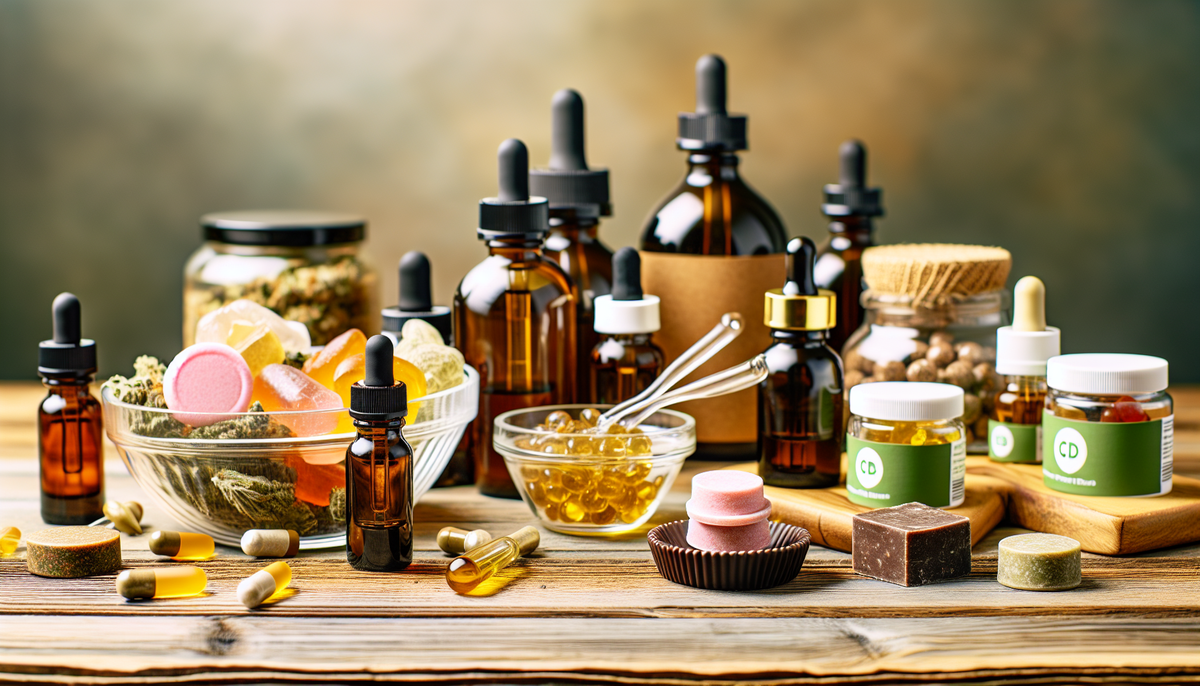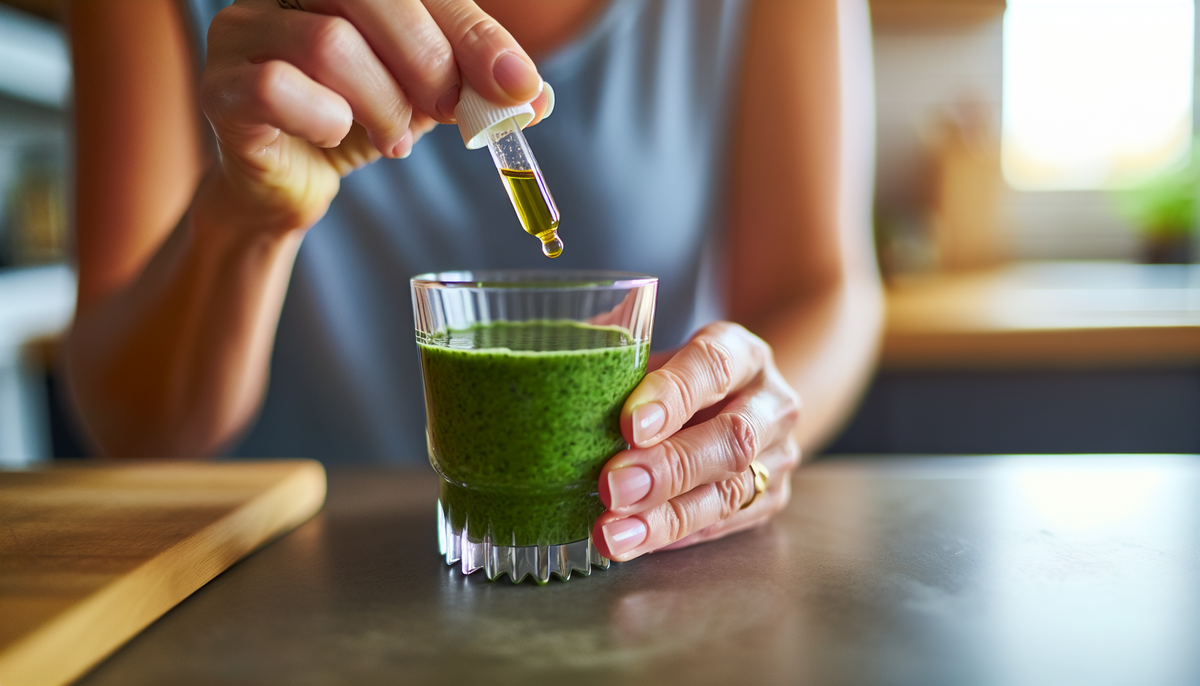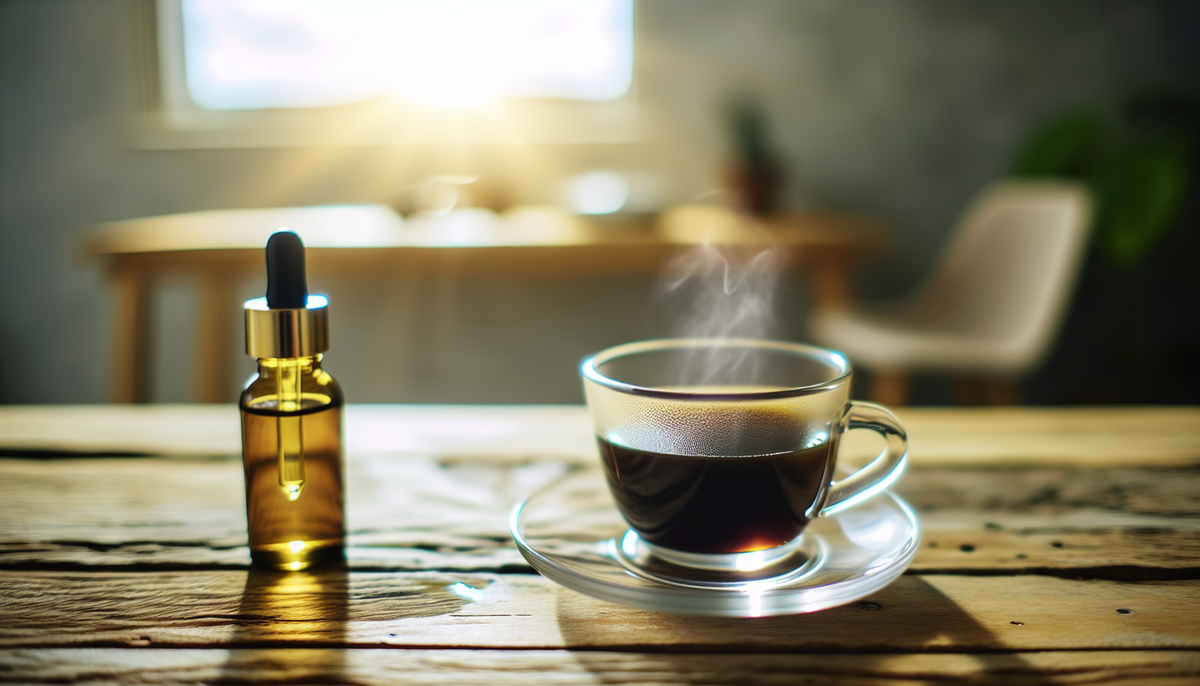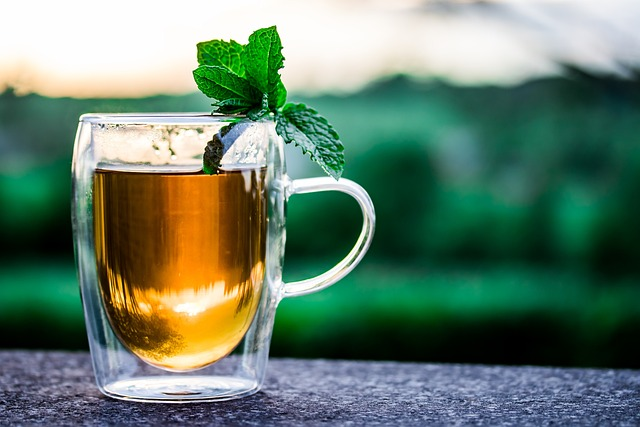Best Ways to Take CBD Oil: Expert Tips
Written by: Daniel Fayad, Subject Matter Expert and Website President
Published: March 15, 2024; Last updated: July 3, 2024
- 1. Key Takeaways
- 2. Exploring CBD Oil Delivery Methods
- 2.1 Sublingual Absorption: The Fast Track to Relief
- 2.2 Incorporating CBD Oil into Your Diet
- 2.3 Topical Solutions for Targeted Comfort
- 3. Mastering the Art of Dosing CBD Oil
- 3.1 Finding Your Starting Point: Low and Slow
- 3.2 Dialing in Your Dosage: Tracking and Adjusting
- 4. The Synergy of CBD Oil with Other Cannabinoids
- 4.1 Full Spectrum CBD: Harnessing the Whole Plant
- 4.2 Broad Spectrum Oils: THC-Free Options
- 4.3 CBD Oil Isolate: Pure CBD
- 5. The Science Behind CBD Oil Absorption
- 5.1 Bioavailability Basics: Maximizing CBD Uptake
- 5.2 Carrier Oils: Enhancing CBD’s Natural Form
- 6. Combining CBD Oil with Your Daily Routine
- 6.1 Morning Rituals with CBD
- 6.2 Evening Wind-Down with CBD
- 7. Choosing the Right CBD Product for You
- 7.1 Deciphering Labels: CBD Content and Quality
- 7.2 Beyond the Label: Third-Party Testing and Certifications
- 8. Summary
- 9. Frequently Asked Questions
- 9.1 How do I get the best results from CBD oil?
- 9.2 What is the downside of CBD oil?
- 9.3 How much CBD is safe to drink?
- 9.4 What is the most effective method for taking CBD oil?
- 9.5 What is the difference between full-spectrum and broad-spectrum CBD oil?
- 10. References
Seeking the best way to take CBD oil? Look no further. We’re here to distill the efficacy of sublingual drops, the ease of edibles, and the precision of topicals. Perfect your CBD experience with our clear-cut guidance tailored to your health concerns and preferences.
Key Takeaways
There are multiple ways to administer CBD oil—sublingually for quick absorption, through ingestion for convenience and prolonged effect, and topically for localized relief—catering to different needs and preferences.
Proper dosing of CBD oil is essential and varies from person to person; starting with a small dose and gradually increasing it is the recommended approach to find the optimal personal dosage.
Full-spectrum and broad-spectrum CBD oils leverage the ‘entourage effect’ by including additional cannabinoids, offering a synergistic impact and potentially enhanced benefits compared to isolated CBD.
Exploring CBD Oil Delivery Methods

CBD oil has gained popularity due to its versatility in how it can be consumed. From sublingual absorption to dietary incorporation and topical application, the ways to take CBD oil are as diverse as the individuals who use it. Each method delivers CBD to your system in unique ways, offering varying onset times and levels of effect. The ideal method for taking CBD oil varies based on individual preferences and needs.
Sublingual absorption is a fast and efficient way to take CBD oil. A few drops of CBD oil are placed under the tongue, allowing the compounds to be absorbed directly into the bloodstream. Alternatively, you can incorporate CBD oil into your diet. CBD oil drops can be added to your favorite beverages or meals, providing a seamless and enjoyable way to consume CBD. Topical applications, on the other hand, offer targeted relief. By mixing CBD oil with lotions, balms, or creams, you can apply CBD directly to your skin. Each of these delivery methods has its advantages. We will examine each one in detail.
Sublingual Absorption: The Fast Track to Relief
The sublingual method of taking CBD oil is often favored by those seeking fast relief. The CBD is absorbed directly into your bloodstream by placing a few drops of CBD oil under your tongue. This allows for a quicker onset of effects compared to other methods, providing rapid relief. ¹
Initiating your CBD regimen through sublingual absorption is straightforward. Here are the steps to follow:
Begin with a low concentration.
As indicated on the packaging, adhere to a low application of no more than 70 mg daily.
You can gradually increase the dosage if you don’t notice any effects within the first week.
This method is effective and efficient, providing quick relief from symptoms such as chronic pain, anxiety, and even seizures.
Incorporating CBD Oil into Your Diet

Incorporating CBD oil into your diet is another effective way to consume CBD. Ingesting CBD oil through CBD capsules and soft gels can be easily swallowed with water, providing a precise dosage without the robust and earthy taste that some individuals may find unpleasant. They offer a convenient and straightforward method of consumption.
CBD edibles, such as CBD gummies, capsules, and soft gels, offer an enjoyable way to consume CBD. With their sweet taste and precise dosage, they provide a pleasurable and inconspicuous method of taking CBD. The recommended daily intake is 2-3 gummies, which may vary based on individual requirements.
Topical Solutions for Targeted Comfort
Topical solutions provide a targeted way to use CBD oil. By mixing CBD oil with products such as lotions, balms, or creams, you can apply CBD directly to your skin. This method is excellent for those seeking targeted relief for specific areas of discomfort or inflammation. ²
Bear in mind that while topicals are effective for localized relief, they may not be as efficient as other delivery methods for broader wellness objectives like stress management or improving sleep. Also, remember that using topicals involves a bit more preparation. It’s advised to cleanse and dry the skin before applying the topical, gently massaging it into the skin until it’s fully absorbed.
Mastering the Art of Dosing CBD Oil
Effective dosing of CBD oil is pivotal to experience its benefits fully. While there’s no one-size-fits-all dosage, there are general guidelines you can follow to find the optimal dosage for your needs. The key is starting with a low dose and gradually adjusting based on your needs and experiences.
Determining the correct dosage may require some experimentation. Everyone’s body reacts differently to CBD oil, influenced by body weight, metabolism, and the severity of the symptoms you’re trying to alleviate. You can monitor your body’s reaction and adjust your dosage by starting low and slow.
Finding Your Starting Point: Low and Slow
Starting with a low CBD oil dose and slowly increasing it over time is the most advisable way to begin your journey with CBD. By starting low, you can gauge your body’s reaction to CBD and reduce the likelihood of potential side effects.
The recommended initial dosage for CBD oil is 10mg when determining how much CBD to take. If you don’t notice any improvements within the first week, you can increase the dosage in 5mg increments every 2 to 3 days. This method allows you to adjust the dosage until you find the best amount gradually.
Dialing in Your Dosage: Tracking and Adjusting
Tracking and adjusting your CBD oil dosage is essential to finding the right amount for your needs. It allows you to understand how your body reacts to different dosages and helps you find the optimal dosage that provides the desired effects.
Factors like body weight, tolerance level, and desired effects should be considered when adjusting your CBD oil dosage. For instance, if you’re taking CBD oil for pain relief, you might need a higher dosage compared to someone taking it for general wellness. Additionally, you should also consider the type of CBD extract used. Full-spectrum and broad-spectrum CBD oils contain additional cannabinoids that can enhance the effects of CBD.
The Synergy of CBD Oil with Other Cannabinoids
CBD oil is not the only beneficial compound found in the hemp plant. Other cannabinoids, such as THC, CBG, and CBN, can also offer numerous health benefits. Full-spectrum and broad-spectrum CBD oils come with these extra cannabinoids, showing a synergistic effect called the “entourage effect.” CBD oil tinctures, especially those that are full-spectrum or broad-spectrum, also provide these benefits.
Full-spectrum CBD oil contains all the cannabinoids found in the hemp plant, including THC. On the other hand, broad-spectrum CBD oil offers a THC-free option while still containing other beneficial cannabinoids. Both these oils allow you to experience the full benefits of the hemp plant, enhancing the effectiveness of CBD.
Full Spectrum CBD: Harnessing the Whole Plant
Full-spectrum CBD oil is a powerhouse of beneficial cannabinoids. It contains all the compounds naturally present in the cannabis plant, enhancing the therapeutic properties of CBD through a phenomenon known as the entourage effect. This effect refers to the synergistic interaction between CBD and other cannabinoids, which can result in heightened relaxation, enhanced pain relief, and improved mood. ³
Utilizing full-spectrum CBD oil means tapping into the entire plant’s potential. In addition to CBD, full-spectrum oil contains cannabinoids like CBN, CBC, CBG, and trace amounts of THC. These cannabinoids work together to provide a more comprehensive range of benefits than CBD alone.
Broad Spectrum Oils: THC-Free Options
If you’re looking to avoid THC while still benefiting from the entourage effect, broad-spectrum CBD oil could be the perfect option for you. Broad-spectrum CBD oil contains all the beneficial compounds found in the cannabis plant except for THC. This makes it a fantastic choice for those who are sensitive to THC or who must avoid it due to drug testing. ⁴
Broad-spectrum CBD oil provides a range of benefits, from anxiety relief to improved heart health. And because it’s THC-free, you can experience these benefits without worrying about the psychoactive effects associated with THC. It’s a win-win situation!
CBD Oil Isolate: Pure CBD
If you’re looking to avoid THC and the entourage effect, CBD oil isolate is the way to go, you can learn more here.
The Science Behind CBD Oil Absorption
Grasping the science underpinning CBD oil absorption can assist in maximizing its benefits. Two key concepts in this regard are bioavailability and carrier oils. Bioavailability refers to the amount of CBD that your body can absorb and use, while carrier oils can enhance the absorption of CBD oil by increasing its solubility and stability.
Bioavailability varies depending on the method of CBD oil consumption. For instance, smoking CBD exhibits a bioavailability of approximately 31%, while oral consumption may have a lower bioavailability, ranging from 13% to 19%. However, using carrier oils can improve the bioavailability of CBD, ensuring that your body can absorb and utilize more CBD.
Bioavailability Basics: Maximizing CBD Uptake
Bioavailability is a crucial factor in how effectively your body can use CBD. It refers to the quantity of CBD that your body can absorb and use. The higher the bioavailability, the more CBD your body can use. Several factors, including the delivery method and formulation of the CBD product, can influence bioavailability.
Specific methods of delivery can enhance the bioavailability of CBD. For example, techniques that enhance the aqueous solubility of CBD, such as incorporating it with cyclodextrins, can enhance bioavailability. Specific delivery methods like MCT/LCT have also been determined to be more advantageous for CBD transport and absorption.
Carrier Oils: Enhancing CBD’s Natural Form
Carrier oils play a vital role in enhancing the absorption and effectiveness of CBD oil. They not only increase the solubility of CBD but also improve its stability, ensuring that the CBD remains effective for longer.
Specific carrier oils, like MCT or hemp seed oil, can boost CBD absorption. MCT oil, in particular, is favored due to its exceptional bioavailability and its ability to be readily absorbed by the body.
Hemp seed oil, on the other hand, not only enhances the absorption of CBD but also provides additional health benefits such as lowering blood pressure and reducing inflammation.
Combining CBD Oil with Your Daily Routine

Integrating CBD oil into your everyday regimen can pave the way for regular and lasting benefits. Whether you’re seeking to start your day with an energy boost or wind down in the evening with a calming ritual, CBD oil can be an integral part of your daily wellness routine.
Adding CBD oil to your morning coffee or smoothie can help kickstart your day, increasing focus and energy. On the other hand, using CBD oil mixed in the evening can promote relaxation and improve sleep quality.
We will investigate how CBD oil can be integrated into your morning and evening routines.
Morning Rituals with CBD
Starting your day with CBD oil can set a positive tone for the rest of your day. CBD oil can enhance energy levels and focus, making it a great addition to your morning routine. Adding CBD oil to your morning coffee or tea can give you a gentle energy boost to start your day.
It’s not just about energy and focus, though. CBD oil also has potential benefits like pain relief and alleviation of symptoms associated with mental health conditions. Incorporating it into your morning routine can help you manage these conditions and maintain your mental well-being throughout the day.
Evening Wind-Down with CBD

CBD oil in the evening can help you wind down after a long day. Here are some ways to incorporate CBD oil into your evening routine:
Take a relaxing bath with CBD-infused bath salts or oils
Enjoy a cup of CBD-infused tea before bed
Use CBD-infused skincare products as part of your nighttime skincare routine
Incorporating CBD oil into your evening routine can promote relaxation and improve sleep quality.
Not only can CBD oil help you relax, but it can also improve the quality and duration of your sleep. It promotes the body’s natural progression through sleep stages, ensuring a restful night’s sleep. Whether you’re struggling with insomnia or looking to improve your sleep quality, incorporating CBD oil into your evening routine is the solution you need.
Choosing the Right CBD Product for You
Selecting the appropriate CBD products requires:
Understanding the product labels
Knowing the CBD content
Being aware of the quality of the product
Looking for third-party testing and certifications to ensure safety, purity, and potency
Understanding CBD product labels can help you make an informed choice. The label should contain information like:
CBD and THC concentrations
List of ingredients
Net quantity of contents
Contact information of the company
We will examine how to interpret labels and the significance of third-party testing and certifications.
Deciphering Labels: CBD Content and Quality
Interpreting CBD product labels may appear challenging, but it’s a crucial step in selecting the appropriate product. The CBD content on the label indicates the percentage of CBD present in the product. Verifying this information against the Certificate of Analysis (COA) provided by a third-party lab is also important.
Quality is another critical factor. The best way to ensure the quality of a CBD product is by checking for third-party lab testing. A Certificate of Analysis (COA) from an independent lab can confirm the product’s quality, purity, and potency, giving you peace of mind that you’re choosing a safe and effective product.
Beyond the Label: Third-Party Testing and Certifications
Looking beyond the label, third-party testing and certifications further ensure the product’s quality. Third-party testing involves an independent lab testing the product for quality, purity, and potency. The lab issues a Certificate of Analysis (COA) that provides a detailed account of the test results.
Certifications, such as CBD and Hemp Product Certification and Good Manufacturing Practices (GMP) Certification, further endorse the quality of the product. These certifications ensure the product has been manufactured in a quality-controlled environment and adheres to strict safety and quality standards.
Summary
We’ve journeyed through the world of CBD oil, exploring its various delivery methods, understanding the art of dosing, appreciating the synergy of CBD with other cannabinoids, getting behind the science of its absorption, and learning how to incorporate it into our daily routines. We’ve also stressed the importance of choosing the right CBD product, deciphering labels, and acknowledging the significance of third-party testing and certifications. As you embark on your CBD journey, remember that every individual’s experience with CBD is unique. Start low and slow, adjust your dosage based on your needs, and always choose quality products from reputable brands. Here’s to unlocking the best way to take CBD oil for optimal results!
Frequently Asked Questions
How do I get the best results from CBD oil?
For the best results from CBD oil, consider taking a tincture sublingually by dropping it under your tongue, waiting a few seconds, and then swallowing. Remember that the benefits are more about cumulative long-term effects than immediate results.
What is the downside of CBD oil?
CBD oil can have side effects such as dry mouth, low blood pressure, and drowsiness. It can also interact with medications like blood thinners; product purity and dosage can be unreliable. Be cautious of these factors before using CBD oil.
How much CBD is safe to drink?
The safe daily dose of CBD can range between 20 and 1,500 milligrams, depending on factors like body weight, individual body chemistry, tolerance, and treatment goals. It’s essential to start with a lower dose and monitor how your body responds to find the right amount for you.
What is the most effective method for taking CBD oil?
The most effective method for taking CBD oil depends on your needs and preferences. Sublingual absorption offers quick relief and seamless dietary incorporation, and topical solutions provide targeted relief.
What is the difference between full-spectrum and broad-spectrum CBD oil?
The main difference between full-spectrum and broad-spectrum CBD oil is that full-spectrum contains THC, while broad-spectrum is THC-free. Therefore, broad-spectrum CBD oil is a better option for those looking to avoid THC in their CBD products.
Can CBD oil cause gastritis?
While it is not a common side effect, it may be possible in some cases. We wrote an article on this which you can check out at https://cannajoint.co/cbd/oil/gastritis/.
References
Johnson, D. A., Funnell, M. P., Heaney, L. M., Cable, T. G., Wheeler, P. C., Bailey, S. J., Clifford, T., & James, L. J. (2023). Cannabidiol Oil Ingested as Sublingual Drops or Within Gelatin Capsules Shows Similar Pharmacokinetic Profiles in Healthy Males. Cannabis and cannabinoid research, 10.1089/can.2023.0117. Advance online publication. https://doi.org/10.1089/can.2023.0117
Makhakhe L. (2022). Topical cannabidiol (CBD) in skin pathology – A comprehensive review and prospects for new therapeutic opportunities. South African family practice : official journal of the South African Academy of Family Practice/Primary Care, 64(1), e1–e4. https://doi.org/10.4102/safp.v64i1.5493
Vigil, J. M., Montera, M. A., Pentkowski, N. S., Diviant, J. P., Orozco, J., Ortiz, A. L., Rael, L. J., & Westlund, K. N. (2020). The Therapeutic Effectiveness of Full Spectrum Hemp Oil Using a Chronic Neuropathic Pain Model. Life (Basel, Switzerland), 10(5), 69. https://doi.org/10.3390/life10050069
Shanmugasundaram, D., & Roza, J. M. (2023). Effect of Broad-Spectrum Hemp Extract on Neurobehavioral Activity on the Immobilization Stress-Induced Model in Sprague Dawley Rats. TheScientificWorldJournal, 2023, 3425576. https://doi.org/10.1155/2023/3425576

Written by Daniel Fayad - Subject Matter Expert and Website President
Dan Fayad is a results-driven healthcare administration expert and content writer. With a Master of Health Administration from the University of Southern California, he’s carved a niche for himself in the dynamic world of healthcare and business development. Dan uses his experience to educate and empower people on their wellness journeys.
Join the CBDeals Club!
Get 10% off your first order and receive our best and exclusive promotions directly to your inbox!

